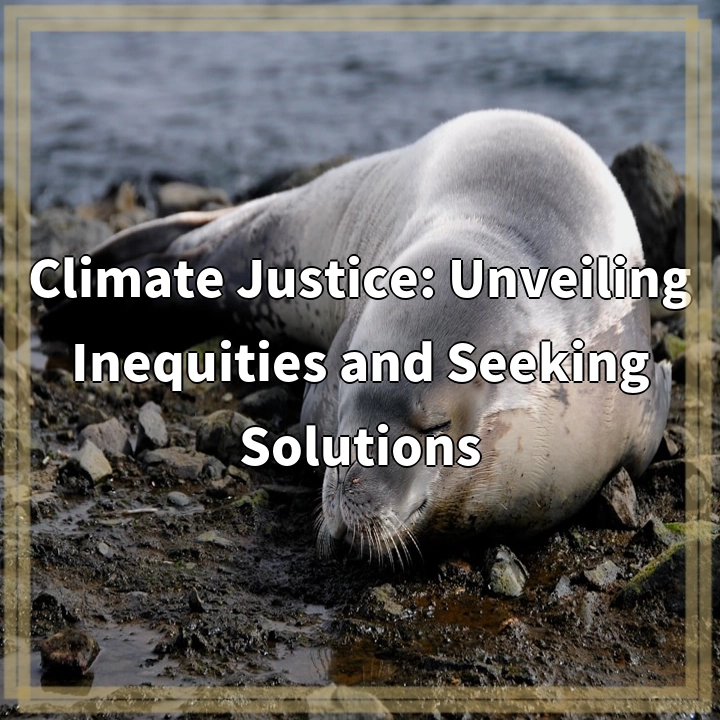Physical Address
304 North Cardinal St.
Dorchester Center, MA 02124
Physical Address
304 North Cardinal St.
Dorchester Center, MA 02124

Climate justice refers to the intersection of climate change and social justice. It recognizes that the impacts of climate change are not distributed evenly across the globe, with marginalized communities and developing countries often bearing the brunt of its consequences. It advocates for fair treatment, inclusion, and equal distribution of the benefits and burdens of climate change mitigation and adaptation measures.
1. Disproportionate Vulnerability and Impacts
Climate change exacerbates existing inequalities, making marginalized communities, such as low-income groups, indigenous peoples, and minority populations, more vulnerable to its impacts. These communities often face higher exposure to climate-related hazards, limited access to resources and services, and inadequate infrastructure and housing, amplifying the risks they face.
2. Inequitable Access to Resources
Unequal access to resources becomes more evident with climate change. Wealthy nations typically have access to the financial and technological resources needed for mitigation and adaptation efforts, while developing countries often lack the necessary funding and support. This exacerbates the inequality gap, leaving disadvantaged communities struggling to cope with climate change and hindering their ability to build resilience.
3. Environmental Racism
Climate change intersects with environmental racism, where marginalized communities and people of color are disproportionately exposed to environmental hazards and pollution. These communities often reside near industrial sites, landfills, and other environmentally harmful facilities, and when disasters strike, they are typically the last to receive aid and face the slowest recovery.
4. Loss of Traditional Livelihoods
Climate change impacts, such as extreme weather events and changing ecosystems, threaten traditional livelihoods tied to the land and natural resources. Indigenous communities and small-scale farmers are particularly at risk as their cultural heritage, subsistence farming, and traditional knowledge systems face disruption, leading to food insecurity and economic instability.
5. Global Power Imbalances
Climate justice highlights the power imbalances in global decision-making processes related to climate change. The voices and interests of marginalized communities are often marginalized or ignored in international negotiations and policy discussions. This hampers efforts to create inclusive strategies that address the root causes of climate change and promote equitable solutions.
1. Just Transition
A just transition involves shifting from a fossil fuel-based economy to a low-carbon and sustainable one while ensuring the rights and well-being of workers and communities affected by this transition. This includes providing job training, support for alternative employment opportunities, and social safety nets to ensure a smooth and equitable transition for all.
2. Empowering Marginalized Communities
It is crucial to empower marginalized communities by including them in decision-making processes and giving them a platform to voice their concerns and needs. This can be achieved through community-based initiatives, participatory planning, and fostering partnerships that respect local knowledge and incorporate diverse perspectives.
3. Redistributing Resources and Wealth
Addressing climate justice requires the redistribution of resources and wealth to ensure equal access to opportunities and benefits. This involves providing financial and technological support to developing countries, investing in sustainable development projects, and implementing policies that reduce inequalities and promote social and economic justice.
4. Strengthening Environmental Regulations
To combat environmental racism and protect marginalized communities, it is essential to strengthen environmental regulations and ensure their fair implementation. This includes enforcing laws that prevent the disproportionate siting of polluting industries in marginalized areas, improving pollution monitoring and remediation efforts, and holding corporations accountable for their environmental impact.
5. Education and Awareness
Education and awareness play a vital role in promoting climate justice. By increasing public understanding of the interconnections between social justice and climate change, we can foster support for equitable solutions and inspire individuals to take action. This includes integrating climate justice into school curricula, sharing diverse stories and experiences, and utilizing various media platforms to reach a wider audience.
Conclusion
Addressing climate justice necessitates a comprehensive approach that addresses the root causes of inequality and works towards equitable outcomes. By implementing these solutions, we can strive towards a more just and sustainable future for all.
If you’re wondering where the article came from!
#